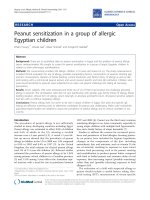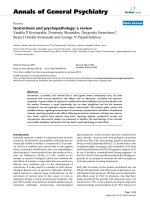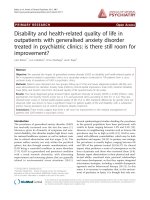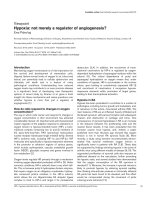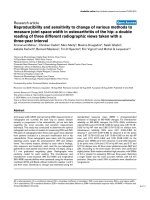Báo cáo y học: "''''Foot'''' and ''''surgeon'''': a tale of two definitions" doc
Bạn đang xem bản rút gọn của tài liệu. Xem và tải ngay bản đầy đủ của tài liệu tại đây (2.77 MB, 5 trang )
JOURNAL OF FOOT
AND ANKLE RESEARCH
'Foot' and 'surgeon': a tale of two definitions
Menz et al.
Menz et al. Journal of Foot and Ankle Research 2010, 3:30
(18 December 2010)
EDIT OR I A L Open Access
’Foot’ and ‘surgeon’: a tale of two definitions
Hylton B Menz
1*
, Alan M Borthwick
2
, Mike J Potter
2
, Karl B Landorf
1,3
, Shannon E Munteanu
1,3
Abstract
Recent events in the USA and UK have raised questions about the appropriate definition and application of the
terms ‘foot’ and ‘surgeon’. In this editorial, we explore these issues and clarify our use of these terms in the journal.
Introduction
“When I use a word” , Humpty Dumpty said, in rather a
scornful tone, “it means just what I ch oose it to mean -
neither more nor less”.
Lewis Carroll, Through the Looking-Glass, and What
Alice Found There (1871)
Semantics is defined by the Oxford Dictionary as the
branch of linguistics and logic concerned with meaning
[1]. However, in a broader sense, the term is also com-
monly used to describe petty or trivial quibbling over
meaning ( as in ‘semantic arguments’), or to describe the
deliberate distortion or twisting of meaning (as in so me
types of advertising or propaganda). That the very defini-
tion of a word that defines the science of meaning is so
demonstrative regarding the uses and abuses of language
confirms Orwell’ s assertion that “ if thought corrupts
language, language can also corrupt thought” [2].
The issue of semantics has recently been highlighted
in two separate but related issues of relevance to the
foot health professions. Although as the editors of Jo ur-
nal of Foot and Ankle Research (JFAR)wewouldprefer
not to become entangled in political or legal debates,
the very title of our journal in some ways forces us to
respond to these issues. The first relates to the very defi-
nition of ‘ foot’, and the second relates to the definition
of the term ‘surgeon’ . Both terms, as expected, have
been used extensively in the journal since its inception
in July 2008, and it is only now that we have felt the
need to define them, or at least justify our use of them.
What connects the foot bone to the leg bone?
The traditional spiritual song Dem Dry Bones, thought
to have been written by African-American songwriter
James Weldon Johnson (1871-1938), has been used for
decades to teach basic anatomy to children, and includes
the lyric “The foot bone’s connected to the leg bone”
[3]. Where the ankle fits into this schema could be the
topic of a n entertaining semantic debate amongst foot
health specialists, yet this very question forms the basis
ofadrawn-outlegalcaseintheUSA.Thedetailsare
freely accessible online [4-7], but what follows is a brief
chronology of events related to the case.
In 2000, the Texas State Board of Podiatric Medical
Examiners (TSBPME) argued that due to uncertainty
among podiatrists, insurance companies and hospitals
regarding the scope of practice of podiatry, there was a
need to define the word ‘ foot’ . The definition they
proposed was:
“The foot is the tibia and fibula in their articulation
with the talus, and all bones to the toes, inclusive of
all soft tissues (muscles, nerves, vascular structures,
tendons, ligaments and any other anatomical struc-
tures) that insert into the tibia and fibula in their
articulation with the talus and all bones to the toes”.
This definition was adopted by the TSBPME in April
2001 [4], despite objections from the Texas Medical
Association (TMA) and the Texas Orthopaedic Associa-
tion (TOA), who claimed that the definition inherently
(and impermissibly) expanded the scope o f practice of
podiatry. The Texan Attorney General concurred, stat-
ing that the tibia and fibula are leg bones, not foot
bones, and as such are beyond the scope of podiatry.
The TMA and TOA then filed legal action in November
2002 requesting that the Travis County District Court
evaluate the validity of the definition.
In August 2005, the Dist rict Court concluded that the
TSBPME definition was valid, prompting the TMA and
TOA to take the case to the Texas Court of Appeals in
* Correspondence:
1
Musculoskeletal Research Centre, Faculty of Health Sciences, La Trobe
University, Bundoora, Victoria, Australia
Full list of author information is available at the end of the article
Menz et al. Journal of Foot and Ankle Research 2010, 3:30
/>JOURNAL OF FOOT
AND ANKLE RESEARCH
© 2010 Menz et al; licensee BioMed Central Ltd. This is an Open Access article distributed under the terms of the Creative Commons
Attribution License ( which permits unrestricted use, distribut ion, and reproduction in
any medium, provided the origina l work is properly cited.
March 2008. At this hearing, the court found in favour
of the TMA and TOA, and reversed the judgement of
the District Court. In their ruling, the Court of Appeals
stated that because the definition included parts of the
body that were neither part of the foot or the ankle
(such as various nerves and b lood vessels that traverse
the leg and terminate in the f oot), the District Court
ruling effectively authorised podiatrists to undertake
procedures outside of their training, thereby constituting
an unauthorised practice of medicine. Interestingly, the
ruling did acknowledge that “a compelling argument
might be made as to whether - from a medical stand-
point - it is reasonable to allow a practitioner treating
the foot to consider and treat other anatomical systems
that interact with and affect the foot”,althoughitwas
specified that a legal case would need to be made to
support this [6].
In August 2008, the Texas Podiatric Medical Associa-
tion (TPMA) and TSBPME appealed the case to the
Texas Supreme Cour t, which was denied in June 2010,
and a subsequent request to rehear the case was turned
down by the Supreme Court in July 2010 [5]. As a
result, the TSBPME definition of the f oot is now
accepted as being legally invalid. However, legal opinion
obtained by the TPMA argues that treatment of the
ankle is still within the scope of podiatry practice in
Texas, as the definition of the foot specified in the
Court of Appeals’ decision is “limited to that portion of
the body at or below the ankle” (emphasis added) [7].
The legal wrangling in this case is clearly driven by
scope of practice, professional autonomy, m edico-legal
and monetary considerations rather than a desire to
anatomically locate the talus, and indeed, it is interesting
to contemplate how the arguments may have differed if
the warring parties were societies of clinical anatomists
rather than podiatrists and orthopaedic surgeons.
Although the case does not currently have any implica-
tions beyond the state of Texas, there is a real possibility
tha t it could set a precedent in other states of the USA,
the UK or Australia, or indeed wherever scope of prac-
tice conflicts arise between podiatrists and orthopaedic
surgeons.
The broader issue raised by this case, however, is that
there remains some confusion as to how the foot should
be defined. Most dictionaries define the foot by what it
is not, i.e. the part of the body below the a nkle [1]. This
is clearly problematic, as the talus could justifiably be
considered to be part of both the ankle and the foot. It
could also be argued, from a functional anatomy and
biomechanical perspective, that no clear distinction
between the foot and the ankle can be made, as move-
ment of the ankle joint induces movement in foot joints,
and vice versa [8]. Even more broadly, there are practical
problems with any segmental definition o f the foot due
to the array of muscular, neural and vascular connec-
tions of more proximal structures, although such con-
siderations proved to be the undoing of the somewhat
expansive TSBPME definition.
In some respects, JFAR has deftly side-stepped the
issue of defining the foot by the inclusion of ‘ ankle’ in
the title, although we acknowledge that this was merely
good fortune rather than careful planning. In consider-
ing the Texas case, we have nevertheless reflected on
why we decided to include ‘ankle’ in the journal title. At
the time the journal was being developed, several titles
were considered which incorporated various permuta-
tions of the words ‘foot’, ‘ankle’, ‘podiatry’, ‘clinical’ and
‘research’, and we were obviously cognisant of not over-
lapping with existing journal titles. The journal could
have been called Journal of Foot Research,butitwas
assumed (although not explicitly discussed) that because
the foot and ankle are interdependent, and that the
readership of the journal would be involved in treating
ankle as well as foot problems, that Journal of Foot and
Ankle Research was appropriate. We still believe this to
be the case, and therefore feel no need to weigh i nto a
legal, anatomical or semantic debate about where the
foot ends and the ankle begins.
Is a surgeon someone who performs surgery?
Although JFAR is the official publication of two podiatry
organisations, from its inception we have encouraged
submissions from all health professionals, in the hope
that the journal would foster greater awareness of, and
collaboration between these disciplines [9]. Admittedly,
this is a somewhat ambitious goal, and it is certainly too
early to evaluate whether it has been achieved. However,
we have already received, reviewed and published sub-
missions from several different professions, including
orthopaedic surgery, and we are grateful that differences
in clinical treatment philosophies and scope of practice
do not appear to be a barrier to publishing in the jour-
nal. However, it was perhaps inevitable that inter-profes-
sional conflicts would eventually arise, which takes us
onto the second topic of this editorial related to the
problem of definitions.
Earlier this year, we received a manuscript which was
subsequently sent for peer review to two referees - in
this case, both were podiatrists, one of whom was a
podiatric surgeon. As JFAR has an open peer review pol-
icy, the identity of authors and referees is freely
disclosed, and referees are also able to view each other’s
recommendations. Furthermore, when a manuscript is
published, all readers can access the pre-publication his-
tory of the manuscript, which includes all referees’ com-
ments and the authors’ responses. In reviewing the
manuscript in question, one of the referees, who works
within an orthopaedic centre, queried the use of the
Menz et al. Journal of Foot and Ankle Research 2010, 3:30
/>Page 2 of 4
term ‘podiatric surgeon’ and suggested that the authors
change this to ‘ surgical podiatrist ’. He justified this
request on the grounds that the use of the title ‘surgeon ’
by podiatrists practising foot s urgery in the UK is con-
sidered controversial, having been the subject of both
press and television attention recently [10-12]. In fact,
use of the titles ‘surgeon’ an d ‘consultant’ have been
hotly contested for some time [13-17]. Nevertheless, our
reviewer’s request met with disapproval from the second
referee, a podiatric surgeon, who wished to correspond
with his co-reviewer on the matter, and asked the
editors to provide a contact email address to enable him
to do so. Given the open access ethos of the jo urnal,
we considered that this was appropriate. Even if we
declined this request, a contact email address could
have been easily retrieved though an internet search
engine.
We were not party to the subsequent correspondence,
but presumably the podiatric surgeon would have offered
afirmdefenceoftheuseofthetitle‘surgeon’ when pre-
fixed by the term ‘podiatric’ . Indeed, in the light of the
recent decision by the Health Professions Council (HPC),
the UK’ s regulatory body for allied health professions
(including podiatry) to u ndertake a public consultation
on the annotation of post-registration qualificati ons,
notably for neuropsychology and podiatric surgery, the
issue of title assumes even greater significance. In its con-
sultation documentation, the HPC clearly acknowle dges
that the terms ‘ consultant po diatric surgeon’ and ‘podia-
tric surgeon’ have bee n used within the National Health
Service for over 10 years, and tha t podiatric surgeons are
employed in that capacity, and currently use the title
[18]. Annotation on the HPC register, however, is also
likely to involve legislative protection of a title, and if this
is to be the case, presumably the chosen designatio n will
accurately reflect the role whilst avoiding ambiguity. As
far as the editors of JFAR are concerned, the issue left to
consider in this particular case was whether or not to for-
ward (and therefore editorially endorse) the referee’s sug-
gested alteration to the authors’ use of the title. We
decided against doing so, for reasons we will outl ine
shortly. In the end, the paper was not accepted for publi-
cation for several reasons unrelated to the use of the title
‘podiatric surgeon’, but the manuscript did prompt some
consideration as to how such an issue would be ma naged
should it arise in the future.
The adoption of definitions and the use of professional
titles by journals invariably confer a degree of legitimacy
on them, so careful consideration needs to be given
when the use of such terms is in dispute. This is parti-
cularly true when the journal readership spans two
potentially dissenting groups, such as orthopaedic and
podiatric surgeons, which are known to contest titles
such as ‘surgeon’ and ‘ consultant’ [14,19]. However, it is
not the role of a research journal to takes sides in such
debates, which are often conducted in a politico-legal
context beyond the scope of the journal’s objectives.
Indeed, as a journal with an international reach and
remit, it is not always helpful, or even desirabl e, to alter
course in response to disputes which emerge in one
nation state but not in others. At the same time, it is
not always possible to av oid taking a position, and the
use of the word ‘surgeon’ is a clear example of this.
After some deliberation, we have taken the view that the
term ‘po
diatric surgeon’ is appropriate, based on the
simple semantic premise that a surgeon is someone who
practices surgery. It could be argued that the suggested
alternative, ‘surgical podiatrist’ is also semantically cor-
rect. However, this usage is inconsistent with other
applications of the term (e.g. there are dental surgeons,
not surgical dentists) and it is not widely adopted by the
organisat ions that represent these groups, and does not,
therefore, adequately perform its descriptive role. The
logic behind the term ‘surgical podiatrist’, as a differen-
tiation from ‘ podiatric surgeon’ ,isalsoflawed-the
adjective ‘surgical’ can be defined as ‘relating to or used
in surgery’, which infers that the podiatrist is performing
surgery, and t he noun for someone who performs sur-
gery is, of course, ‘surgeon’. In addition, ‘podiatric sur-
geon’ isthephraseusedmostwidelyacrossthe
Anglophone world to describe podiatrists who are quali-
fied to practice foot surgery. Nor is it evident that the
use of the term ‘ podiatric surgeon’ implies, or is
intended to imply, that the practitioner is medically qua-
lified as opposed to qualified in podiatry, and therefore
designed in some way to obfuscate or de ceive, as has
been insinuated in some press reports [10-12,17].
Reaching such a decision based primarily on semantics
might seem to be taking the easy option. However, w e
feel that t his is the most appropriate approach to take
for a journal that strives to be inclusive of all healthcare
professionals involved in the management of foot and
ankle disorders. Possibly, some of our orthopaedic read-
ers will disagre e, and perhaps some of our podiatric col-
leagues may be dismayed that we have not more
emphatically advocated the use o f the title on profes-
sional or educational grounds. Nevertheless, debates
regarding the sc ope of practice and associated nomen-
clature of health professions will continue, and the
views of the JFAR editors are unlikely to significantly
influence the outcome. Our job is to get the words
right, which is sometimes more difficult than it appears.
Author details
1
Musculoskeletal Research Centre, Faculty of Health Sciences, La Trobe
University, Bundoora, Victoria, Australia.
2
Faculty of Health Sciences,
University of Southampton, Southampton, UK.
3
Department of Podiatry,
Faculty of Health Sciences, La Trobe University, Bundoora, Victoria, Australia.
Menz et al. Journal of Foot and Ankle Research 2010, 3:30
/>Page 3 of 4
Authors’ contributions
All authors contributed to the writing of the editorial and approved the final
submitted version.
Competing interests
The authors declare that they have no competing interests.
Received: 12 December 2010 Accepted: 18 December 2010
Published: 18 December 2010
References
1. Oxford Dictionaries. [ />2. Orwell G: Politics and the English language. Horizon 1946, 13:252-265.
3. Jeffery DL: Dictionary of Biblical Tradition in English Literature Grand Rapids:
Wm. B. Eerdmans Publishing Company; 1992.
4. Texas Administrative Code, Title 22, Part 18 (Rules). [t.
state.tx.us/agencydocuments/23March2001-TexasRegisterPreamble-
Adoption375.1-Foot.pdf].
5. Supreme Court of Texas Orders Pronounced July 30. 2010 [http://www.
supreme.courts.state.tx.us/historical/2010/jul/073010.htm].
6. Texas Court of Appeals, Third District, At Austin. No. 03-05-00620-CV.
[ />OpinionID=16860].
7. Recent Supreme Court Action Invalidates TSBPME Rule but DPM’s
Scope of Practice Still Includes the Ankle. [ />Supreme_Court.pdf].
8. Nester CJ: Lessons from dynamic cadaver and invasive bone pin studies:
do we know how the foot really moves during gait? J Foot Ankle Res
2009, 2:18.
9. Menz HB, Potter MJ, Borthwick AM, Landorf KB: Welcome to Journal of
Foot and Ankle Research: a new open access journal for foot health
professionals. J Foot Ankle Res 2008, 1:1.
10. BBC London News: Concern over unregulated surgeons. [.
co.uk/go/pr/fr/-/local/london/hi/tv_and_radio/newsid_8400000/8400189.
stm].
11. The Telegraph Online: Medical job titles - what’s in a name? [http://
www.telegraph.co.uk/health/8062112/Medical-job-titles-whats-in-a-name.
html].
12. Johnston L: Unqualified surgeons. Sunday Express. London 2010.
13. The Lancet: Who is a surgeon? Lancet 1995, 345:663-665.
14. Borthwick AM: Challenging medicine: the case of podiatric surgery. Work
Employment Society 2000, 14:269-238.
15. Borthwick AM, Dowd O: Medical dominance or collaborative partnership?
Orthopaedic views on podiatric surgery. Br J Podiatr 2004, 7:36-42.
16. Freudmann S, Caesar B: Why are you training as a surgeon? Ann R Coll
Surg Engl 2004, 86(Suppl):341-343.
17. The Telegraph Online: Podiatrists ‘confuse patients by calling
themselves surgeon’. [ />Podiatrists-confuse-patients-by-calling-themselves-surgeons.html].
18. Health Professions Council: Consultation on our proposals for post-
registration qualifications. London: Health Professions Council; 2010.
19. Isaac A, Gwilym SE, Reilly IN, Kilmartin TE, Ribbans WJ:
Interprofessional
relationships between orthopaedic and podiatric surgeons in the UK.
Ann R Coll Surg Engl 2008, 90:663-670.
doi:10.1186/1757-1146-3-30
Cite this article as: Menz et al.: ’Foot’ and ‘surgeon’: a tale of two
definitions. Journal of Foot and Ankle Research 2010 3:30.
Submit your next manuscript to BioMed Central
and take full advantage of:
• Convenient online submission
• Thorough peer review
• No space constraints or color figure charges
• Immediate publication on acceptance
• Inclusion in PubMed, CAS, Scopus and Google Scholar
• Research which is freely available for redistribution
Submit your manuscript at
www.biomedcentral.com/submit
Menz et al. Journal of Foot and Ankle Research 2010, 3:30
/>Page 4 of 4


